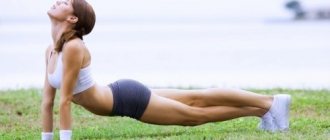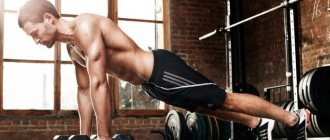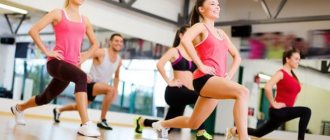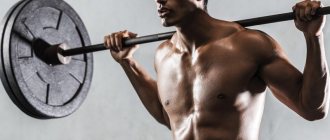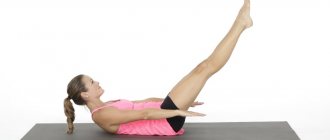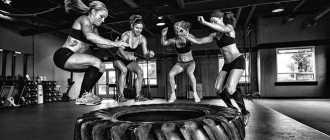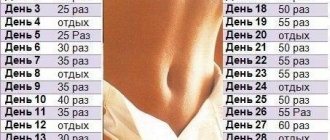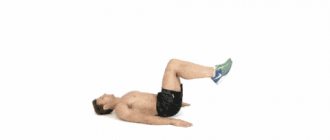Build strong, lean muscles and lose belly and flank fat to make dramatic changes in your fitness in record time with this men's gym workout program and nutrition plan.
How much can you change your body in four weeks? Stronger than you think if you have three things: a good training system, sound nutritional rules and the right attitude to follow them with focus and purpose.
The proposed four-week plan was designed to bulk up in a way that constantly tests your body and pushes it beyond its comfort zone while eliminating your belly and sides. In this case, your body has no choice but to build new muscle mass and burn fat, radically transforming your body. That is why each week of the program contains its own little tricks: these changes will “puzzle” your body and force it to change.
Gym workout plan for men
Totally transforming your body in four weeks is difficult, but possible. Start slowly, both in the gym and in the kitchen, and soon these small steps will significantly transform your shirtless appearance.
Plan
The plan consists of two 2-week blocks. The first is designed for four workouts per week: chest and back; legs and abs; hands; shoulders and abs. The second also includes four training days, but the workouts are different: chest and back, legs and shoulders, chest and triceps, back and biceps.
Powerful start
The workouts for the first week of the first block are given below. Then the tables outline the workouts for the second week of the block. Perform the routines in order, following the number of sets, reps, tempo, and rest periods indicated, to ensure that the start of the plan is as effective as possible.
Tempo refers to the number of seconds it takes to complete each phase of the exercise. Using the bench press as an example, the first number corresponds to the duration of the phase of lowering the weight, the second – the pause at the lower point of the amplitude, the third number indicates the duration of raising the weight, and, finally, the fourth – the pause at the upper point of the amplitude.
Bench Press Example
Temp 2010 means:
- 2 seconds lower the weight
- We rest for 0 seconds at the bottom point, that is, we immediately return to the starting position
- Raise the weight up for 1 second
- We rest for 0 seconds at the top point of the amplitude, that is, we immediately lower the barbell down
Grand finale
A significant difference in the second week of the block is that you will work the chest, back and arms twice a week. This increase in training volume shocks the body into building more muscle and burning excess fat, so you get bigger and leaner at the same time.
Steady progress
The complexes consist of the same exercises in the same order for the first and second, third and fourth weeks. But the number of sets and reps varies to push your body to its limits. This approach will accelerate the onset of positive changes in your physical fitness.
Have a rest
Let's be honest: the suggested four-week plan is very difficult, but otherwise there is no way you will change your body for the better in such a short time. This means that good nutrition and quality rest are key. Follow the nutrition guidelines below to ensure your body gets what it needs, and try to go to bed early every night.
Where to start training for men at home
You always need to start with the basics. A lot depends on a person’s physical fitness. But we will consider the training process, naturally, for a beginner. In a person who has never played sports, or a lot of time has passed since exercise, the body is completely unprepared for physical activity. Ligaments and muscles do not have the strength or elasticity necessary to perform exercises. By the way, even athletes of the highest level, after a long pause, should start with something simple, this applies to both the intensity of training and the working weight used.
So where should you start doing full body workouts at home?
The best option would be to create a workout consisting of exercises with your own weight and, of course, a thorough warm-up.
Let's take a closer look at training. It should be taken into account that training can be aimed at achieving different goals.
- If the goal of exercise is to gain muscle mass, then you can’t do without weight training. Moreover, without having sports weightlifting equipment with the possibility of large weights, progress will stop too quickly. Again, this is purely individual and depends on the person’s physical fitness.
- If we talk about developing endurance - activities to maintain physical fitness and general well-being, then at home you can create an excellent place for training! By the way, training aimed at creating a beautiful, aesthetic and harmonious figure, albeit with small, but perfectly defined, relief muscles, is also relevant for the home.
As already mentioned, training must begin with a full warm-up, thanks to which the athlete will prepare the body for the upcoming load.
- The first step is to perform one or more cardio exercises. These may include jumping rope, running, and an exercise bike.
- You can do squats with your own weight, and burpees are also suitable as a warm-up.
- After warming up exercises, you should perform a set of movements aimed at stretching the muscles and ligaments. As an example, this type of exercise includes bending and turning the body, as well as rotating joints. Read more about joint gymnastics →
- An excellent option is a training process that includes running.
- Even experienced athletes should not neglect the warm-up, and if we are talking about beginners, then special attention should be paid to this part of the training process.
Nutrition tips
To build lean muscle mass and achieve a flat stomach, the food you eat is no less important than a good training program in the gym for men for relief. Follow these four rules to succeed.
Protein
If you don't eat enough protein - white and red meat, fish and eggs - don't be surprised if your muscles grow slower than you'd like. Lifting heavy weights creates microscopic tears in the muscles, and it is protein that heals these wounds and builds stronger, more voluminous muscle tissue. Try to eat high-quality, lean protein in at least fist-sized portions at each meal.
Carbohydrates
You don't have to give up carbs completely to transform your body. Instead, choosing your carbohydrate sources wisely will help you get bigger, stronger, and more ripped. Avoid sugar and cut down on fast-digesting carbohydrates like white bread and pasta, which are stripped of the lion's share of their nutrients and fibre. Instead, opt for slow-digesting carbohydrates such as sweet potatoes, brown rice, and plenty of nutritious, fiber-rich vegetables.
Vegetables
If you fail to consume five servings of fruits and vegetables per day according to the famous "five-a-day" system, you are depriving yourself of a lot of vitamins, minerals and other essential nutrients that can give you good health and a lean body. Eat plenty of vegetables of different colors to provide your body with the nutrients it needs after a hard workout. In addition, fiber will help you feel fuller longer and stabilize your blood sugar levels, so you won't crave sweets.
Alcohol
To get maximum results within four weeks, you should completely eliminate alcohol. It's full of calories you don't need, and drinking too much will kill your desire to train hard and eat right. Your best option is to drink plain water, green tea and black coffee to stay hydrated and get antioxidants that will help you recover from your workout.
How to create an effective individual set of exercises for all muscle groups
The main goal of the first training is to prepare the body for further stress, increase endurance, and improve the quality characteristics of muscles and joints (mobility and elasticity). The psychological factor also plays an important role. Getting ready to regularly visit the gym and actively work in it is already half the success.
Fullbody is rightfully considered the best program for beginner athletes. This training system allows you to work all major muscle groups in one session. Experienced athletes rarely use it, except for the purpose of minor weight loss, mainly devoting a lot of time to each part of the body separately.
Another difference between the fullbody is the regular working out of each muscle group 2-3 times a week. This training option is not suitable for professionals, since often due to high loads and a long recovery period, they pump the muscles of one area 1-2 times every 7-8 days.
You can create an individual complex yourself or with the help of a trainer. In most cases, the training plan should take into account:
- age;
- health status;
- mode.
Age restrictions determine the permissible list of exercises performed. So, a 17-year-old should not include heavy deadlifts in his program.
Contraindications for health reasons must also be taken into account when developing the complex. For people suffering from varicose veins, they reduce the load on their legs.
The mode and main work activity are also important. They determine the training time, as well as the permissible load. So, the types of exercises for a loader and a clerk will definitely be different.
For the convenience of drawing up a program, the whole body can be divided into separate muscle groups:
- biceps and triceps;
- breast;
- back;
- shoulder section;
- press;
- buttocks;
- hips;
- legs.
From this division, you can begin to work on writing a plan. It is recommended to take the “base” as a basis - multi-component exercises that involve several types of muscles at once. This contributes to better development and reduces training time.
Important! When implementing the fullbody system, it is necessary to strictly follow the technique of performing the element and not increase the number of weekly workouts, otherwise the muscles will not have time to recover and become injured.
Be sure to watch: Lose weight in the gym: every girl’s dream or reality Gym training program for girls How to use exercise equipment in the gym How long should you exercise in the gym: research on the duration and frequency of training
Block 1: Week 1
Monday Workout: Chest and Back
Bench press
Sets 3 Reps 10 Tempo 2010 Rest 60 sec.
Lie down on a horizontal bench, grab the bar with a shoulder-width grip. Place your feet on the floor and tense your muscles. Lower the bar until it touches your chest, then forcefully press it up.
Bent over row
Sets 3 Reps 10 Tempo 2011 Rest 60 sec.
Stand up straight, holding a barbell with an overhand grip shoulder-width apart. Lean forward from the hip joint, but keep your chest up and your core tight. Pull the bar towards your body by bending your elbows, hold at the top point and lower.
Dumbbell flyes lying on an incline bench
Sets 3 Reps 10 Tempo 2010 Rest 60 sec.
Lie on an incline bench with your head up, holding two dumbbells straight above your chest. Bend your elbows slightly, then slowly lower your arms to your sides until you feel a stretch in your chest muscles. Contract your pectoral muscles to return to the starting position.
Wide grip lat pulldown to chest
Sets 3 Reps 10 Tempo 2011 Rest 60 sec.
Sit on the machine, grasping the handle with an overhand grip shoulder-width apart. Keeping your chest up and your abs tight, pull the handle down, bending your elbows. Pause at the bottom for a second and return to the starting position.
One-arm crossover press
Sets 3 Reps 10 Tempo 2 0 1 1 Rest 60 sec.
Stand with your back to the crossover with the D-handle in one hand. Push your chest up, tighten your abs, and press one arm forward, straightening your elbow. Go back and complete all reps, then switch hands.
Pullover with dumbbell
Sets 3 Reps 10 Tempo 4 0 1 0 Rest 60 sec.
Lie on a horizontal bench, pressing your back firmly against it and holding a dumbbell with both straight arms above your chest. Slowly and in a controlled manner, lower the dumbbell behind your head with straight arms, then lift it up to the starting position.
Wednesday Workout: Legs and Abs
Back Squat
Sets 3 Reps 10 Tempo 2 0 1 0 Rest 60 sec.
Stand up straight with the bar resting on your rear deltoids. Lifting your chest and squeezing your entire body, bend your knees and lower yourself into a squat as low as possible without letting your knees roll inward. Push through your heels and lift yourself up.
Romanian deadlift
Sets 3 Reps 10 Tempo 2 0 1 0 Rest 60 sec.
Stand up straight, grasping the barbell with an overhand grip. With your chest up and your core engaged, bend forward at the hip, sliding the bar along the front of your legs until you feel a stretch in the back of your thighs. Climb up.
Leg extension in the simulator
Sets 3 Reps 10 Tempo 2 0 1 1 Rest 60 sec.
Sit on the machine in the correct position, with the soft roller at the front of your lower legs. Tighten your upper body muscles and lift your feet, extending your legs. Pause at the top, squeezing your quadriceps, then return to the starting position.
Leg bending in the simulator
Sets 3 Reps 10 Tempo 2 0 1 0 Rest 60 sec.
Sit on the machine and take the correct starting position: the soft roller should touch the back of the bottom of your legs. Keeping your core muscles tense, lower your feet down, bending your legs. Pause at the bottom point, contracting the hamstring muscles, and return to the starting position.
Crunches
Sets 3 Reps 10 Tempo 2 0 1 1 Rest 60 sec.
Lie on your back, bring your hands to your temples and bend your knees. Contract your upper abdominal muscles and lift your body off the floor, then do a crunch, reaching your body toward your knees. Slowly lower yourself to the floor, keeping your abs tense the entire time.
Plank
Approaches 3 Time 30 sec. Tempo – Rest 60 sec.
Get into position with your elbows under your shoulders, your feet together, your hips lifted, and your abs and glutes squeezed so that your body forms a straight line from head to heels. Maintain this position without letting your hips sag.
Friday Workout: Biceps and Triceps
Reverse grip lat pulldown
Sets 3 Reps 10 Tempo 2 0 1 1 Rest 60 sec.
Sit on the machine, grasping the handle with a reverse grip shoulder-width apart. Lift your chest, tighten your abs, and pull the handle down by bending your elbows. Pause for a second at the bottom and return to the starting position.
Dips
Sets 3 Reps 6-10 Tempo 2 0 1 0 Rest 60 sec.
Get into a parallel bars position with your arms straight and feet crossed behind you. Keeping your chest lifted and your abs engaged, bend your elbows to a 90-degree angle as you lower yourself down. Push yourself up, returning to the starting position.
Dumbbell biceps curl
Sets 3 Reps 10 Tempo 2 0 1 1 Rest 60 sec.
Stand up straight, hold a dumbbell in each hand, with your arms facing forward. Keep your elbows close to your sides and lift the dumbbells toward your shoulders. Squeeze your biceps at the top, then lower the dumbbells to the starting position.
Triceps dumbbell extension
Sets 3 Reps 10 Tempo 2 0 1 0 Rest 60 sec.
Stand up straight, take a dumbbell in each hand, holding them behind your head with straight arms. Making sure your elbows point straight toward the ceiling, lower the dumbbells behind your head, then straighten your arms, returning to the starting position.
Crossover biceps curl
Sets 3 Reps 10 Tempo 2 0 1 1 Rest 60 sec.
Face the crossover, attach a double rope handle to the top block and grab it with an underhand grip. Point your chest up, press your elbows toward your body, and bend your arms to shoulder level. Squeeze your biceps at the top and lower your arms.
6. Crossover triceps extensions
Sets 3 Reps 10 Tempo 2 0 1 1 Rest 60 sec.
Facing the crossover, grab the double rope handle attached to the upper pulley with an overhand grip. Lifting your chest and pressing your elbows towards your torso, press up by straightening your arms, then slowly return to the starting position.
Saturday Workout: Shoulders and Arms
Seated dumbbell press
Sets 3 Reps 10 Tempo 2 0 1 0 Rest 60 sec.
Sit on a vertical bench, holding a dumbbell in each hand at shoulder level. Keep your chest lifted and core tight and press the dumbbells vertically upward, straightening your arms. Slowly lower the dumbbells to the starting position.
Swing dumbbells from side to side while seated
Sets 3 Reps 10 Tempo 2 0 1 0 Rest 60 sec.
Sit on a vertical bench press, hold a light dumbbell in each hand and bend your elbows slightly. Push your chest up, tighten your core, and lift the dumbbells out to your sides until you reach shoulder level, starting at your elbows, then slowly return to the starting position.
Vertical EZ bar to chin
Sets 3 Reps 10 Tempo 2 0 1 1 Rest 60 sec.
Stand up straight, holding an EZ barbell with an overhand grip. With your chest up and core engaged, lift the barbell up to chin height, starting the movement by bending your elbows. Pause at the top, then return the barbell to the starting position in a controlled manner.
Hanging Knee Raise
Sets 3 Reps 10 Tempo 1 1 1 1 Rest 60 sec.
Hang on the horizontal bar, grasping it with an overhand grip and straightening your legs. Squeezing your core, glutes, and keeping your feet together, draw your knees toward your chest. Hold this position, then straighten your legs and return to the starting position.
Weighted crunches
Sets 3 Reps 10 Tempo 2 0 1 1 Rest 60 sec.
Lie on a horizontal bench, holding a dumbbell or weight plate in front of your chest with bent arms, bend your knees. Engage your upper abs and lift your torso off the bench, then twist your upper body, bringing your torso toward your knees. Lower yourself slowly.
Reverse crunches
Sets 3 Reps 10 Tempo 2 0 1 1 Rest 60 sec.
Lie on the floor on your back with your arms extended along your body and your knees bent. Tighten your entire abs and, using the lower part of it, pull your knees to your chest, then lift your pelvis off the floor. Return to the starting position.
Principles of successful training
To achieve your desired goals, you will have to become a meticulous home trainer. For men, as well as for women, it is very important to follow the following rules:
- Never start an activity without an intensive warm-up. Even while training at home, you can get injured and forget about sports for a long time. Moreover, it is necessary to warm up not only those muscles that will work during training, but also those that are not planned to be loaded. It is necessary to prepare the entire body for training. You need to start warming up with slow, calm movements and gradually increase the pace.
- Moderate stretching is very helpful. Thanks to stretching, you will be able to recover faster after training, which means your muscles will grow more intensely.
- The main thing is regularity of classes. The ideal training frequency is 3 times a week. Exercising 1-2 times a week is not enough, but working out every day is not at all an option; with such a rhythm, the muscles do not have time to recover, which means they will not be able to grow.
Working out at the gym with an instructor or friend is much easier than doing it at home. Working out at home can present the following difficulties:
- Lack of motivation. There are many like-minded people in the gym and a sports atmosphere is constantly maintained, so it is much easier to be motivated for success. However, there are groups on social networks where guys talk about their achievements and communicate with each other. This will make up for the lack of communication with like-minded people.
- Lack of specialized equipment. The fitness club has a lot of equipment for any purpose, a huge selection of free weights of all sizes. This makes training much easier.
- Inability to correct equipment. It is very important to do the exercises correctly. At home, you won’t be able to ask a professional for advice, which means you’ll have to learn from your own personal experience.
Achieving results at home will take longer than in the gym. If these factors do not cause fear, you can move on to the preparatory part - choosing a program for classes.
Block 1: Week 2
Continue to build lean muscle mass and lose belly fat by working out even harder.
With four Week 1 workouts under your belt, you can already start to feel a little stronger, lighter, and more agile. That's why we're now going to up the ante to accelerate your positive progress.
The four workouts of the second week are similar to those of the first. You will work the chest and triceps in the same order; legs and abs; arms and then shoulders and abs. But for greater efficiency, two big changes have been made to the program. First, you will perform one additional set of the first and second exercises of each set. Also, in the last four exercises of each workout, the number of repetitions increases to 12.
For what? Because now you know how to do these exercises correctly, increasing the load on your muscles will force your body to build muscle and burn fat even more intensely. Stay focused and practice proper technique throughout all four workouts for the fastest results.
Monday: Chest and back
| Exercises | Approaches | Repetitions | Pace | Rest |
| 1. Bench press | 4 | 10 | 2 0 1 0 | 60 sec. |
| 2. Bent-over row | 4 | 10 | 2 0 1 1 | 60 sec. |
| 3. Dumbbell flyes lying on an inclined bench with the head end up | 3 | 12 | 2 0 1 0 | 60 sec. |
| 4. Lat pulldown | 3 | 12 | 2 0 1 1 | 60 sec. |
| 5. One-arm crossover press | 3 | 12 | 2 0 1 1 | 60 sec. |
| 6. Pullover with a dumbbell | 3 | 12 | 2 0 1 0 | 60 sec. |
Wednesday: Legs and Abs
| Exercises | Approaches | Repetitions | Pace | Rest |
| 1. Squats | 4 | 10 | 2 0 1 0 | 60 sec. |
| 2. Romanian deadlift | 4 | 10 | 2 0 1 0 | 60 sec. |
| 3. Leg extension in the simulator | 3 | 12 | 2 0 1 1 | 60 sec. |
| 4. Leg curls in the simulator | 3 | 12 | 2 0 1 1 | 60 sec. |
| 5. Crunch | 3 | 12 | 2 0 1 1 | 60 sec. |
| 6. Plank | 3 | 45 sec. | — | 60 sec. |
Friday: Biceps and triceps
| Exercises | Approaches | Repetitions | Pace | Rest |
| 1. Vertical lat pulldown with reverse grip | 4 | 10 | 2 0 1 1 | 60 sec. |
| 2. Dips | 4 | 6-10 | 2 0 1 0 | 60 sec. |
| 3. Dumbbell curls | 3 | 12 | 2 0 1 1 | 60 sec. |
| 4. Triceps dumbbell extension | 3 | 12 | 2 0 1 0 | 60 sec. |
| 5. Crossover hammer curls for biceps | 3 | 12 | 2 0 1 1 | 60 sec. |
| 6. Crossover triceps extension | 3 | 12 | 2 0 1 1 | 60 sec. |
Saturday: Shoulders and Abs
| Exercises | Approaches | Repetitions | Pace | Rest |
| 1. Seated dumbbell press | 4 | 10 | 2 0 1 0 | 60 sec. |
| 2. Seated Dumbbell Side Raise | 4 | 10 | 2 0 1 1 | 60 sec. |
| 3. Vertical traction EZ-bar | 3 | 12 | 2 0 1 1 | 60 sec. |
| 4. Hanging knee raises | 3 | 12 | 2 0 1 1 | 60 sec. |
| 5. Weighted crunches | 3 | 12 | 2 0 1 1 | 60 sec. |
| 6. Inverted crunches | 3 | 12 | 2 0 1 1 | 60 sec. |
Supersets and circuit training
Any program does not last forever, it is advisable to change it every 2-3 months. You can use the following information to add more variety to your training program.
A superset is several exercises that are performed without a break. A superset can be performed for synergistic and antagonistic muscles. For example, alternating between barbell curls and cable extensions is a superset for antagonists. And the bench press and dumbbell flyes are for synergists.
Supersets help overcome upper strength thresholds and increase endurance. They are effective when you reach a plateau and need to create shock loads.
Circuit training is a large number of exercises for different muscle groups, which are performed one after another with a very short break. The number of repetitions here is 15 or more, it is advisable to complete the approach in 20-40 seconds. This option is very grueling and is well suited for creating relief and burning fat.
Unlike supersets, it is better to work in machines here. You can include a circuit option in your program once a week.
Block 2: Week 1
Workout 1: Chest and Back
Bench press at an angle
Sets 4 Reps 10 Tempo 3 0 1 0 Rest 60 sec.
Lie down on an incline bench and grab the bar with an overhand grip. Press your feet to the floor and tense your muscles. Lower the bar until it touches your chest, then jerk it up.
Wide-grip lat pull-down to chest
Sets 4 Reps 10 Tempo 3 0 1 0 Rest 60 sec.
Sit on the machine, grasping the handle with a wide grip, twice as wide as your shoulders. With your chest up and your abs tightened, pull the handle down by bending your elbows. Pause at the bottom for a second and return to the top.
Dumbbell Bench Press
Sets 4 Reps 10 Tempo 3 0 1 0 Rest 60 sec.
Lie down on a bench, take a dumbbell in each hand and hold them at chest level. Place your feet on the floor and tense your muscles. Press the dumbbells straight up, straightening your arms, then lower them down in a controlled manner.
Seated rowing
Sets 4 Reps 10 Tempo 3 0 1 1 Rest 60 sec.
Sit on the machine, grasping the double handle with both hands. Keeping your chest lifted, pull your arms towards your body from the elbows. Hold the top position and return to the starting position.
One-arm crossover press
Sets 4 Reps 10 Tempo 3 0 1 1 Rest 60 sec.
Stand with your back to the crossover, holding the D-handle in one hand. Push your chest up, tighten your core, and straighten your arm in a pressing motion. Return to the starting position and repeat until the end of the approach, then change hands.
Crossover Straight Arm Press
Sets 4 Reps 10 Tempo 3 0 1 0 Rest 60 sec.
Stand facing the crossover, holding the straight handle with both hands. Keeping your chest up, pull the handle down toward your hips in a slight arc, pause at the bottom, then return to the starting position.
Workout 2: Legs and Shoulders
Back Squats
Sets 4 Reps 10 Tempo 3 0 1 0 Rest 60 sec.
Stand up straight with the bar at the back of your deltoids. Lift your chest, tense your entire body, and bend your knees, squatting as low as possible without your knees falling inward. Push through your heels to rise up.
Army press
Sets 4 Reps 10 Tempo 3 0 1 0 Rest 60 sec.
Stand up straight, holding the bar in front of your chest with an overhand grip. With your chest up and your core engaged, press the barbell up overhead, straightening your arms. Lower the barbell down in a controlled manner, returning to the starting position.
Leg extension in the simulator
Sets 4 Reps 10 Tempo 3 0 1 1 Rest 60 sec.
Sit on the machine in the correct position: the roller is located at the bottom of the front of your shins. Brace your upper body and lift your feet, extending your knees. Pause at the top, activating your quadriceps, and lower your legs to the starting position.
Seated lateral raise of dumbbells
Sets 4 Reps 10 Tempo 3 0 1 1 Rest 60 sec.
Sit on a vertical bench, holding a dumbbell in both hands with your elbows slightly bent. Push your chest up, tighten your core, and lift the dumbbells out to your sides to shoulder height, starting at your elbows. Then slowly return to the starting position.
Leg bending in the simulator
Sets 4 Reps 10 Tempo 3 0 1 1 Rest 60 sec.
Sit on the machine, taking the correct starting position, in which the soft roller is located at the bottom of the legs at the back. Keep your core muscles tight and lower your feet down, bending your knees. Pause at the bottom, squeezing your hamstrings, and return to the starting position.
Vertical EZ bar to chin
Sets 4 Reps 10 Tempo 3 0 1 1 Rest 60 sec.
Stand up straight and grab a barbell with an EZ bar with an overhand grip. Lift your chest, tighten your core, and pull the barbell toward your chin by bending your elbows. Pause at the top and lower the barbell to the starting position in a controlled manner.
Workout 3: Chest and Triceps
Bench press
Sets 4 Reps 10 Tempo 3 0 1 0 Rest 60 sec.
Lie down on a horizontal bench, grasping the bar with a shoulder-width grip. Press your feet to the floor and tense your muscles. Lower the bar until it touches your chest and jerk it up.
Dumbbell flyes lying on an incline bench
Sets 3 Reps 10 Tempo 2 0 1 0 Rest 60 sec.
Lie on an incline bench, holding two dumbbells directly above your chest with straight arms. Bend your elbows slightly and slowly move them apart until you feel a stretch in your chest muscles. Return to the starting position by contracting your pectoral muscles.
Dips
Sets 4 Reps 6-10 Tempo 3 0 1 0 Rest 60 sec.
Take the starting position on the parallel bars, straightening your arms and crossing your feet behind your back. Raise your chest, tighten your abs and lower yourself down, bending your elbows to a right angle. Push your hands up, returning to the starting position.
Incline Dumbbell Press
Sets 4 Reps 10 Tempo 3 0 1 0 Rest 60 sec.
Lie on an incline bench, holding dumbbells in both hands at chest level with your palms facing outward. Place your feet on the floor and tense your muscles. Press the dumbbells straight up, straightening your arms, and lower them down in a controlled manner.
Crossover triceps press
Sets 4 Reps 10 Tempo 3 0 1 0 Rest 60 sec.
Face the crossover and grasp the double rope handle attached to the top pulley with an overhand grip. Lift your chest and tuck your elbows to your sides, press your arms downwards, extending your elbows, then slowly return to the starting position.
Push ups
Sets 4 Reps 10-15 Tempo 3 0 1 0 Rest 60 sec.
Stand in a lying position: place your hands on the floor, shoulders and elbows are on the same line, feet together. Squeeze your core and bring your chest closer to the floor by bending your elbows. Push your hands off the floor, returning to the starting position.
Workout 4: Back and Biceps
Pull-ups
Sets 4 Reps 6-10 Tempo 3 0 1 1 Rest 60 sec.
Hang on the horizontal bar with a reverse grip, hands shoulder-width apart. Squeeze your abdominal muscles and buttocks and, pointing your chest up, pull your torso up until your chin reaches the bar. Hold this position, then slowly return to the starting position.
Wide-grip pull-down to the chest for the latissimus dorsi muscles
Sets 4 Reps 10 Tempo 3 0 1 1 Rest 60 sec.
Take the starting position on the machine, grasping the handle with a straight grip shoulder-width apart. With your chest up and your abs tense, pull your arms toward you by bending your elbows. Pause at the bottom for a second and return to the starting position.
3. Dumbbell Row
Sets 4 Reps 10 Tempo 3 0 1 1 Rest 60 sec.
Lie on your stomach on an incline bench, head end up, with dumbbells in both hands. Keeping your chest pressed against the bench, pull the dumbbells up, starting the movement by bending your elbows. Lock yourself at the top point and lower the dumbbells down, returning to the starting position.
Dumbbell flyes lying face down
Sets 4 Reps 10 Tempo 3 0 1 1 Rest 60 sec.
Lie on your stomach on an incline bench, holding a light dumbbell in each hand. Press your chest against the bench and lift the dumbbells to the sides, starting the movement from your elbows. Pause at the top position and lower the dumbbells to the starting position.
Dumbbell biceps curl
Sets 4 Reps 10 Tempo 3 0 1 1 Rest 60 sec.
Stand up straight, holding a dumbbell in each hand with your palms facing forward. Keeping your elbows close to your body, lift the dumbbells to shoulder level. Squeeze your biceps at the top, then lower the dumbbells to the starting position.
Hammer dumbbell curls
Sets 4 Reps 10 Tempo 3 0 1 1 Rest 60 sec.
Stand straight, dumbbells in both hands, palms facing each other. Keep your elbows close to your sides and lift your arms toward your shoulders. In the upper position, tighten your biceps, then, straightening your arms, return to the starting position.
Basic exercises on simulators for drawing up a plan for beginners
Athletes who are in the “novice” category should familiarize themselves with the basic elements. They are not only effective and time-tested, but also quite simple to implement, so they are suitable for beginners.
The correct “base” allows you to pump up almost the entire muscular system. Only after you have mastered these exercises well can you begin to work each muscle group separately.
Legs
When pumping the legs, the main focus is on the quadriceps, biceps femoris and calves. The best elements to work on these groups would be:
- Squat with a barbell. Quadriceps, glutes, spinal extensors, calves and femurs are pumped. This strength exercise is not recommended for athletes under 18 years of age.
- Leg press on the machine. The quadriceps, gluteal and femoral muscles work.
- Lunges. The gluteal muscles and quadriceps are involved.
- Deadlift with straight legs. The hips and buttocks are pumped.
- Calf raise. A simple calf swing exercise. Can be performed outside the gym. To make it more difficult, weights and dumbbells are used.
Breast
The pectoral muscles are often worked in conjunction with the triceps:
- Bench press. The pecs, deltoids, triceps and abs work.
- Push ups. The pectoral muscles, back, shoulders, triceps, stabilizers are pumped.
- Flying arms with dumbbells. The pectoralis major, deltoids, biceps, triceps and brachialis muscles are involved.
Back
For men and boys, proper back pumping is very important. It is this that allows you to get a beautiful torso with a V-shaped silhouette. The main target of training is the trapezius, latissimus and lumbar muscles:
- Wide grip pull-ups. The exercise targets the biceps and latissimus dorsi muscles.
- Bent-over barbell row. The trapezius, latissimus and posterior delta bundles are loaded.
- Deadlift. The trapezius, gluteal, latissimus muscles, quadriceps, erectors and biceps femoris are “included”.
- Hyperextension on a Roman chair. The spinal erectors, hip flexors and gluteal muscles are pumped.
Biceps
When working on the biceps brachii muscle, the load most often falls on the short and long fascicles of the biceps:
- Biceps curl. There are several variations with grip (narrow, neutral, wide), position (sitting, standing) and type of apparatus (barbell, dumbbells, kettlebells). During the execution of the element, all the main muscles are pumped, including the shoulder and wrist extensors.
- Hammer. In addition to the biceps, the brachialis and wrist flexors are loaded.
- Concentrated dumbbell lift. Activates the brachialis and biceps muscles. Requires the use of large weights.
Triceps
The triceps muscle consists of several main bundles: long, medial and lateral. They make up ⅔ of the shoulder and form the pumped, athletic contour of the arms. Triceps are worked first by beginners:
- Close grip bench press.
- Dips.
- French press.
In all three exercises, all triceps bundles are pumped. The shoulder muscles and wrist flexors are also affected.
Deltas
The deltoid muscles also consist of 3 bundles:
- Army press. The middle bundle is loaded the most.
- Dumbbell fly. All beams are working.
- Lifting projectiles in front of you. The front beams are best worked out. Can be performed alternately and simultaneously.
Forearms
This section includes the extensors, flexors of the wrist and radialis muscles:
- Bending arms with a projectile. Grabbing the bar or dumbbells from above helps to further pump the biceps and brachyradialis.
- Zottman Curls. This element consists of lifting dumbbells followed by supination at the peak point. In addition to the flexors and radialis muscles, the biceps works.
- Bend your arms on a lower block from behind your back. The element is performed on a block simulator; the biceps muscle is additionally pumped.
- Kettlebell snatch with one hand. In addition to the target, the work includes the shoulder muscles.
Press
This area is a problem area for almost every gym goer. Most exercises are aimed at working the rectus and oblique muscles:
- Raising legs from hanging on the bar. Mostly the lower abdominal area works.
- Twisting. The upper area is being pumped.
- Lateral twists from a lying position. The exercises are aimed at working out the oblique muscles.
This training method is perfect for beginner athletes, whose main goal at first is to improve the quality of muscles and joint mobility.
Block 2: week 2
As you noticed in the first week of the second block of this plan, some new movements were introduced into the program to create a stress load on the muscles to support their continued growth. These sets, reps, and tempo have also been adjusted so that each set of each workout challenges the nervous system and muscles a little more. This means that the second block of the plan is mentally and physically more difficult, but stay focused and try to give your best in each set to the best of your ability. And you will be amazed at the results you can achieve in increasing strength, muscle growth and improving body contour.
The final week's workouts are tabulated below, and while they consist of the same exercises in the same order as the first week of the block, the sets and reps are changed again. This means that every time you come to the gym, you will give your muscles a new stress load that they are not used to, because this is the only way to maintain the progress of your results.
Monday: Chest and back
| Exercise | Approaches | Repetitions | Pace | Rest |
| 1 Bench press at an angle | 5 | 10 | 3010 | 60s |
| 2 Wide-grip lat pull-down | 5 | 10 | 3011 | 60s |
| 3 Dumbbell bench press | 4 | 12 | 3010 | 60s |
| 4 Pulldown of the lower block to the siyad belt | 4 | 12 | 3011 | 60s |
| 5 One-arm crossover press | 4 | 12 | 3011 | 60s |
| 6 Straight arm press down in a crossover | 4 | 12 | 3011 | 60s |
Wednesday: Legs and shoulders
| Exercise | Approaches | Repetitions | Pace | Rest |
| 1 Squats | 5 | 10 | 3010 | 60s |
| 2 Standing barbell press | 5 | 10 | 3010 | 60s |
| 3 Seated leg extensions | 4 | 12 | 3011 | 60s |
| 4 Swing dumbbells to the sides | 4 | 12 | 3011 | 60s |
| 5 Lying leg curl | 4 | 12 | 3011 | 60s |
| 6 EZ-bar chin row | 4 | 12 | 3011 | 60s |
Friday: Chest and Triceps
| Exercise | Approaches | Repetitions | Pace | Rest |
| 1 Bench press | 5 | 10 | 3010 | 60s |
| 2 Dumbbell raises at an angle | 5 | 10 | 3011 | 60s |
| 3 Triceps push-ups | 4 | 8-12 | 3010 | 60s |
| 4 Parallel grip dumbbell bench press | 4 | 12 | 3010 | 60s |
| 5 Triceps extensions in the upper block | 4 | 12 | 3011 | 60s |
| 6 Push-ups | 4 | 12-15 | 3010 | 60s |
Saturday: back and biceps
| Exercise | Approaches | Repetitions | Pace | Rest |
| 1 Biceps Pull-Ups | 5 | 06.Oct | 3011 | 60s |
| 2 Wide-grip lat pull-down | 5 | 10 | 3011 | 60s |
| 3 Parallel grip dumbbell rows lying on a bench | 4 | 12 | 3011 | 60s |
| 4 Swing dumbbells to the sides at an angle | 4 | 12 | 3011 | 60s |
| 5 Biceps curls with dumbbells | 4 | 12 | 3011 | 60s |
| 6 Hammer Grip Dumbbell Curls | 4 | 12 | 3011 | 60s |
How can a beginner organize classes without a coach?
Experienced athletes can easily create a suitable training program. Beginners can also do this task if they follow the following rules:
- Preparation of a training plan. At the beginning of any lesson there should be a warm-up (about 15 minutes), 2 ligaments for the main muscle group (for example, legs, back), 2-3 exercises for secondary muscles (for example, biceps, triceps) and a cool-down (5-10 minutes) . If you are focusing on weight loss, you need to leave at least 20 minutes for cardio after standard strength training.
- Setting the frequency. Weakened muscle groups can be trained twice a week with an even break to ensure proper rest for the body.
- Selection of suitable exercises. To begin with, you should choose basic loads or options on simulators. Isolation exercises are added gradually and last to control lagging muscles. The specific list of exercises depends on the availability of specific exercise machines and special equipment in the selected gym.
- Determining the number of approaches. The basic number of individual sets for large muscle groups should be 12-15 (3-4 exercises, 3-4 sets). For the first set, a fairly heavy weight and reduced number of repetitions should be used, and subsequent repetitions should be gradually increased.
Abdominal exercises should be added regardless of the training day, since this area recovers quite quickly.
Cardio system for home
Not everyone has the sole goal of gaining muscle mass. Getting rid of excess weight is no less important. Gymnastics and cardio will help with this. These exercises can also be done at the beginning of strength training to prepare the heart for the load. The most popular and effective cardio options:
- Run in place. You can use the exercise as a warm-up or as independent training. This is almost as effective as jogging outside, the only difference is that the athlete does not have to encounter natural obstacles such as uneven ground underfoot, slopes, etc.
- Jump squats. As you inhale, perform the usual squat, and as you exhale, you need to not just stand up, but intensively push your body up, lifting yourself off the floor. You can add weight to this exercise by picking up a kettlebell or dumbbell.
- Jumping in place with swings (Jumping Jack). You need to stand in a straight position with your legs close to each other. During the jump, the legs open wider, and at the same time the arms rise to the center. Before making the next jump, you must return to your starting position. The exercise is performed without interruption.
- Jumping rope. A pleasant and very effective form of cardio. You can jump in a variety of ways: on the spot, jogging, backwards, forwards, on two or one leg. The rope must be chosen carefully; the equipment must be ideally suited to your height. To understand whether the length of the jump rope is normal, you need to stand on it in the center; if everything is fine, the handles will reach your armpits. When jumping, you must remember to breathe evenly and only through your nose.
You don't have to go to the gym to improve your fitness. This is quite possible to do at home. Such activities will require more effort than training in a fitness club, but with a responsible approach they will definitely give excellent results.
Bodyweight exercises
There are many bodyweight exercises, each athlete has his own favorites. The list of the most effective ones looks something like this:
- Push ups. This is a basic exercise, without which you won’t be able to pump up beautiful breasts. Male parents show it to their teenage sons. There are several options for performing push-ups. To work the pectoral muscles, you need to use a wide stance with your arms and strive to push up as deeply as possible. With a narrow position, the triceps work; this is a difficult, but very effective exercise. You can also do push-ups on parallel bars; finding them won’t be difficult. However, from scratch it is much more difficult than push-ups. If the latter is not going very smoothly yet, you don’t even have to try to master the uneven bars.
- Squats - in any schedule, this is a basic exercise for working the buttocks and legs. To have a noticeable result, weighting is necessary. You can use dumbbells, water bottles, or put on a backpack after filling it with something heavy. Even if it’s easy to squat with weights, you can do it on one leg. An important nuance is that squats with a wide stance are aimed at working the gluteal muscles, while a narrow stance allows you to engage the quadriceps.
- Lunges are a great exercise that targets your glutes, quadriceps, and hamstrings. Learning to do lunges is not so easy; it’s better to watch a video with the technique of this exercise. The main thing is to keep the body perpendicular to the floor.
- Raising your legs on the horizontal bar is the best way to pump up your abs. Most of the load goes to the lower part.
- The classic crunch is the most famous abdominal exercise. The upper abdomen works as much as possible. The main rule is not to lift your lower back off the floor while doing this.
